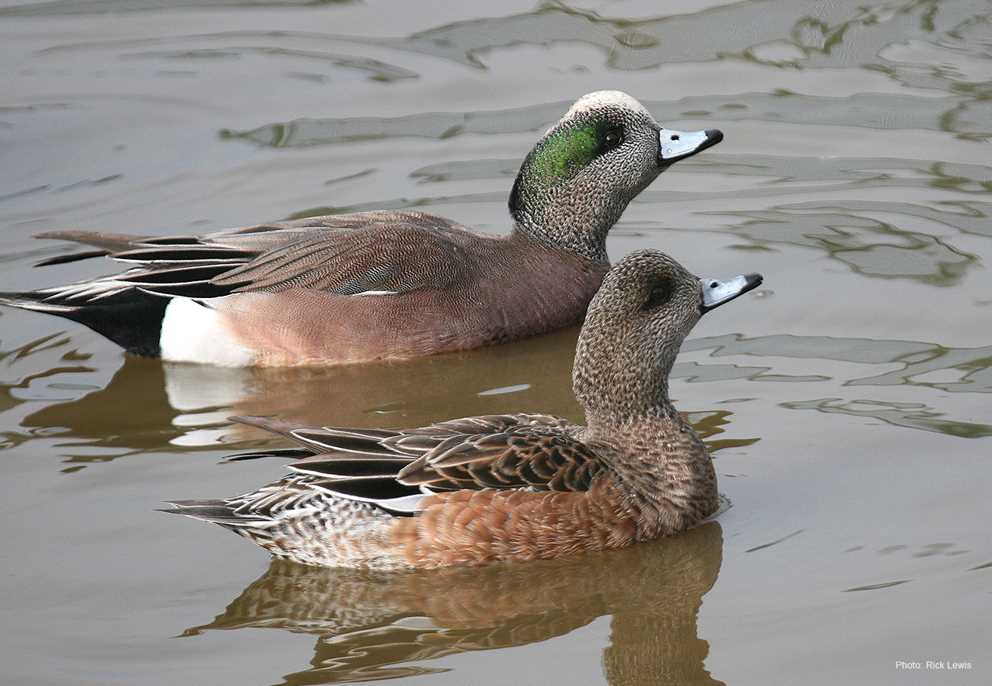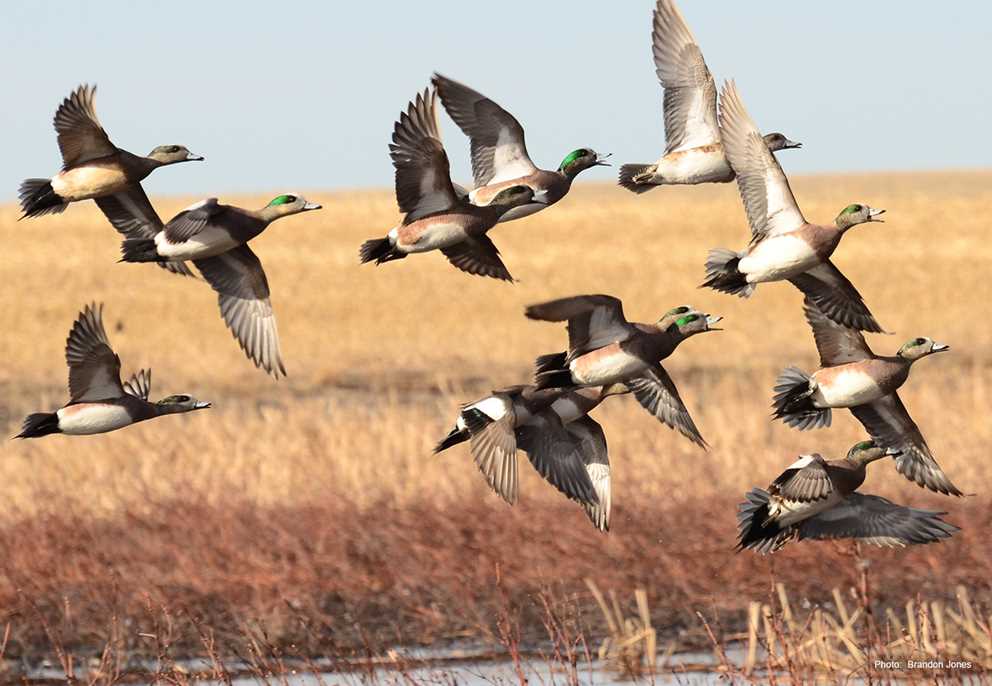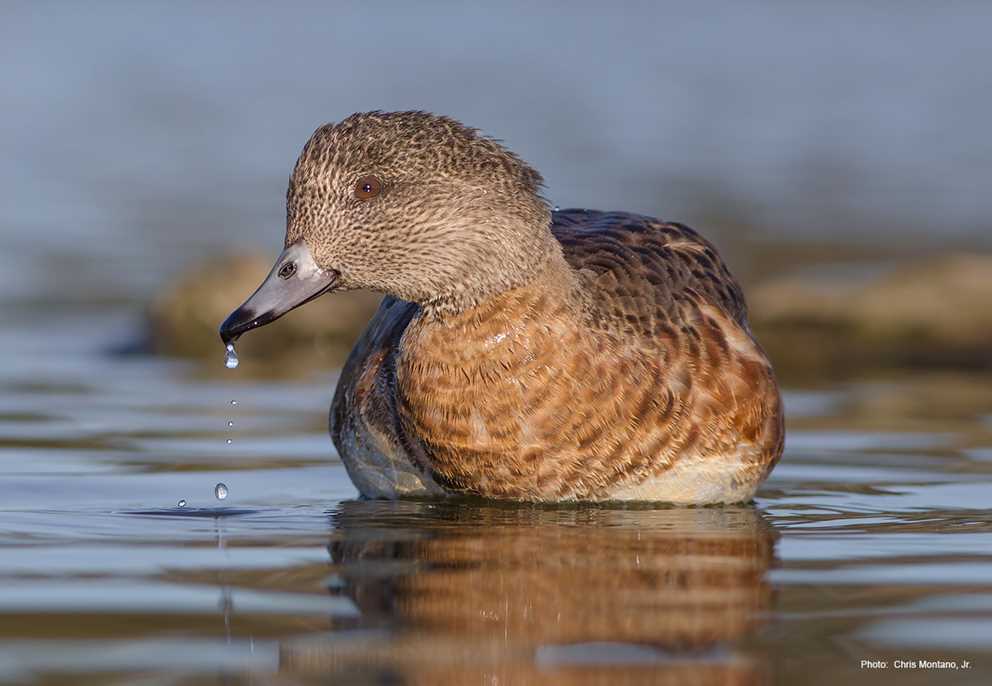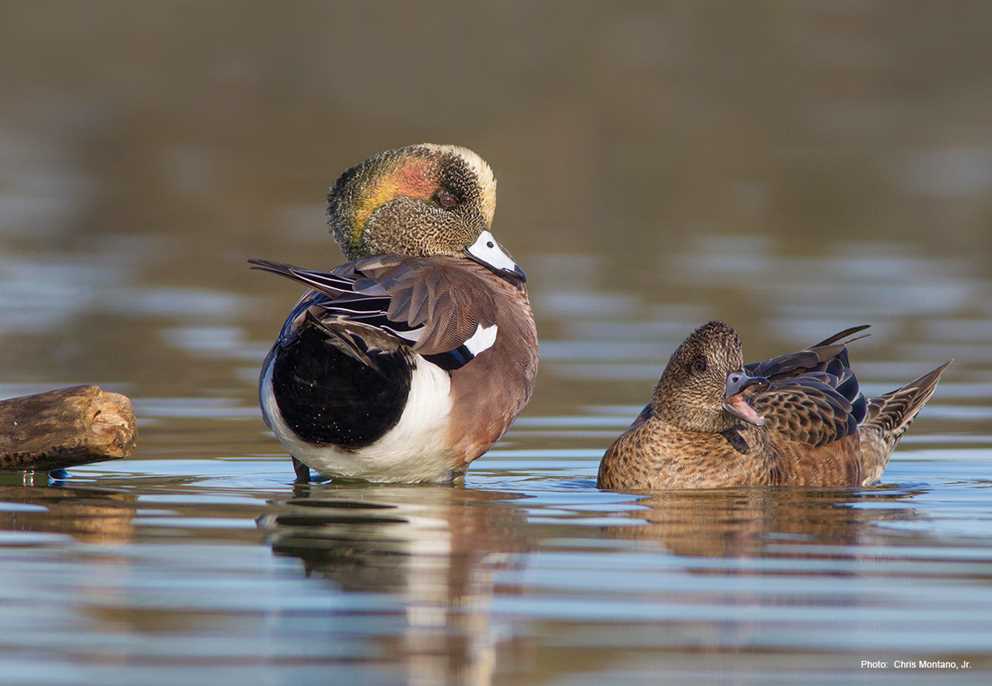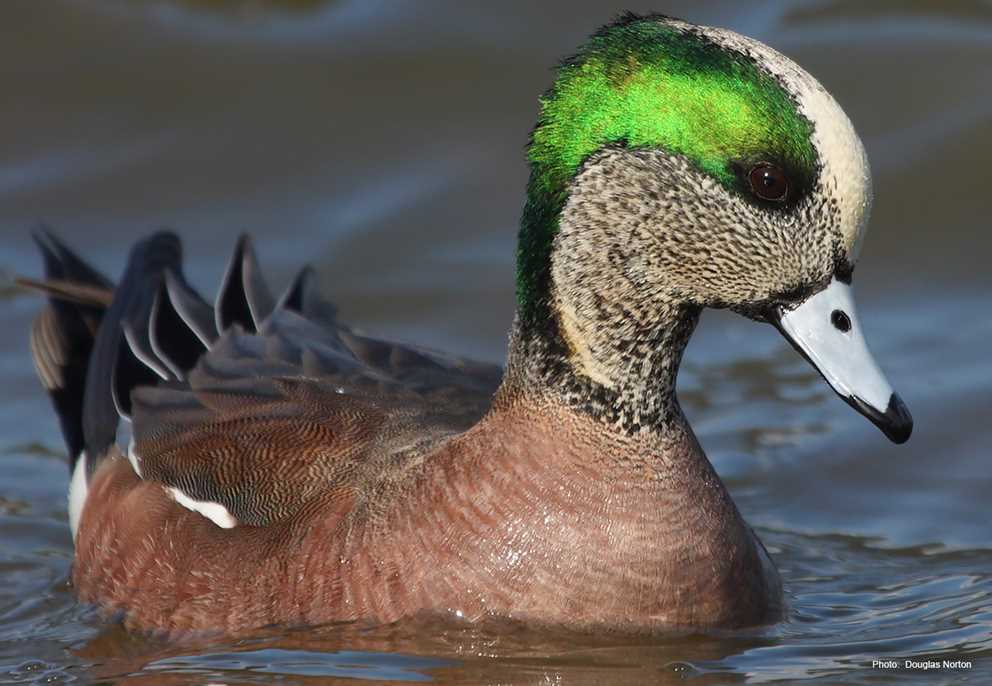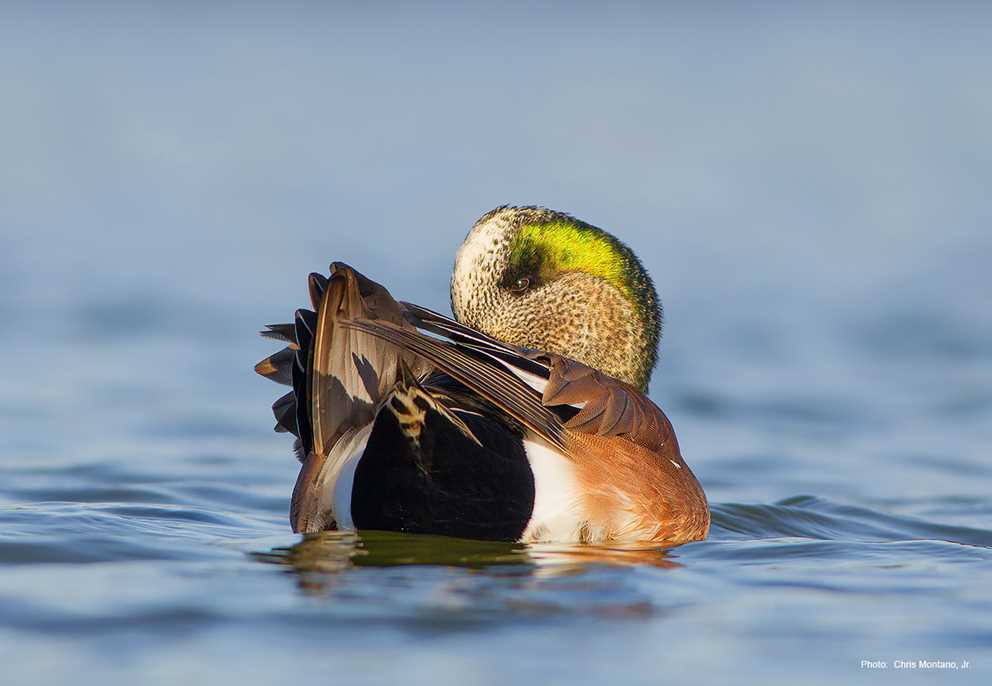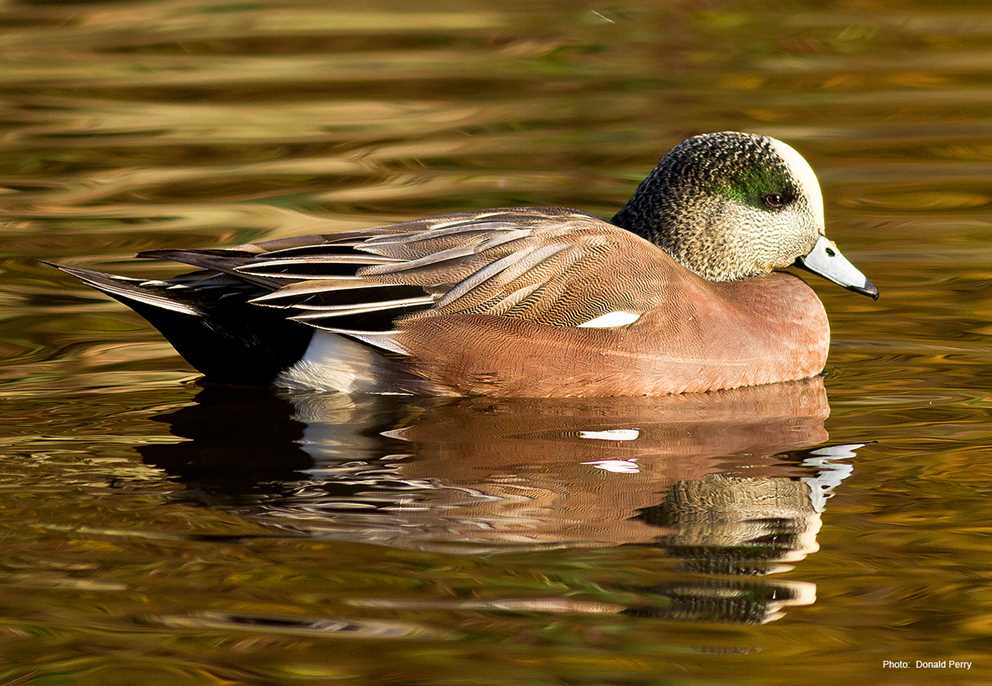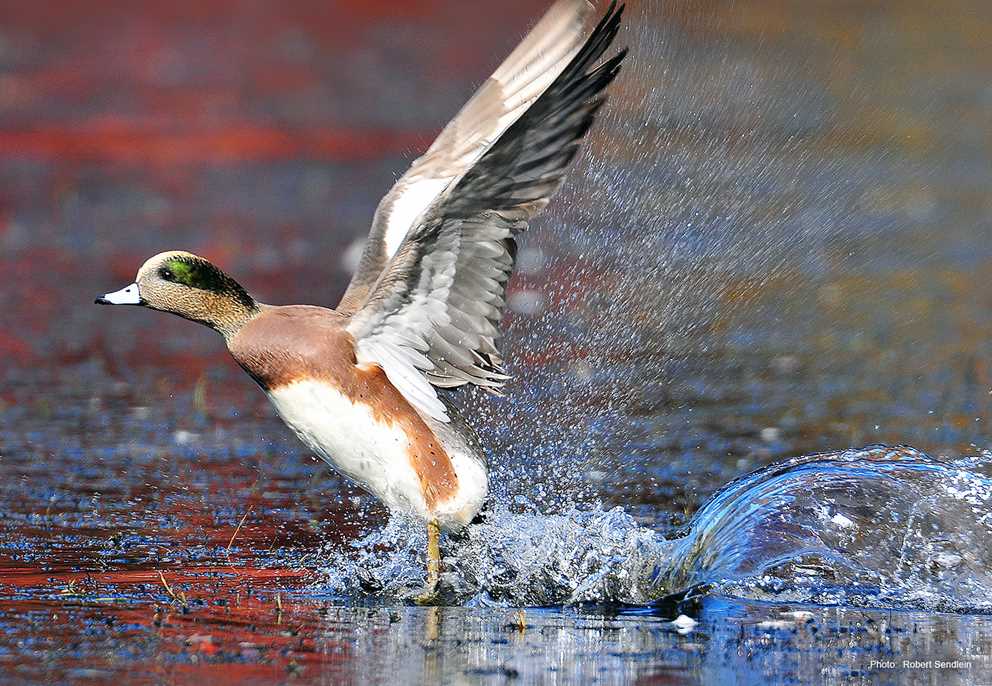Overview
The American Wigeon is a medium-sized dabbling duck whose distribution is restricted to North America. The American Wigeon breeds primarily in boreal, prairie parkland, and some Arctic areas. American Wigeon nests in uplands, often relatively far from water, in tall grass, mixed herbaceous plants, shrubs, or brush. Winter habitat is fresh and brackish wetlands with abundant aquatic vegetation on which they primarily forage, and they feed in upland winter cereal or harvested grain fields. Males in alternate plumage have a distinctive white forehead and crown, an iridescent dark green patch surrounding the eye and extending back onto the crown, with the remainder of the head and neck buffy overall with much black speckling. The breast, sides, and flanks are pinkish brown and contrast with the white belly and sides of the rump. The under-tail coverts are black, the upper tail coverts grayish.
Description
Key Identification Features
- American Wigeon are medium-sized dabbling ducks.
- Males in alternate plumage have a distinctive white forehead and crown, an iridescent dark green patch surrounding the eye and extending back onto the crown, with the remainder of the head and neck buffy overall with much black speckling. In flight, the wings show a notable white patch and iridescent green speculum that separates them from all other species of waterfowl in North America, except the occasional Eurasian Wigeon that winters in North America.
Male/Female Average Length and Weight
- Weight: Males 1.4–2.3 lbs.; Females 1.4–1.9 lbs.
- Wingspan: Males 9.3–10.9 in.; Females 9.2–10.1 in.
Male Identification
- Alternate (Breeding) Plumage: Males in alternate plumage have a white forehead and crown, an iridescent dark green patch surrounding the eye and extending back onto the crown, with the remainder of the head and neck buffy overall with much black speckling. The breast, sides, and flanks are a pinkish-brown color and contrast with the white belly and sides of the rump. The undertail coverts are black, the upper tail coverts grayish. In flight, the wings show a notable white patch and iridescent green speculum. The bill is bluish with a black tip, and the feet and legs are gray.
- Basic Plumage: Overall brownish to brownish red, white belly, fairly dull plumage.
Female Identification
- Alternate (Breeding) Plumage: Females have a dark crown streaked with white, and reddish-brown breast, sides, and flanks that contrast with a white belly. In flight, they show a notable white patch and green speculum on the wing, though not as pronounced as in males. The bill is grayish with a black tip.
- Basic Plumage: Overall brownish to brownish red, white belly, fairly dull plumage.
In-flight Identification
- In flight, the wings show a notable white patch and iridescent green speculum that separates them from all other species of waterfowl in North America, except the occasional Eurasian Wigeon that winters in North America. The bill is bluish with a black tip, and the feet and legs are gray. Females have a dark crown streaked with white, reddish-brown breast, sides, and flanks that contrast with a white belly. In flight, they show a notable white patch and green speculum on the wing, though not as pronounced as in males. The bill is grayish with a black tip.
Vocalizations
- A three-syllable high-pitched whistle “fi-ew-whew” with the loudest or accented part of the call being the middle syllable. Variations on the number of syllables may occur from 1 to 4.
Similar Species
- Eurasian Wigeon: Uncommon to rare in winter in North America. Eurasian Wigeon males have a bright russet head, a cream-colored forehead and crown, and a gray back and sides with substantial black and white vermiculation. Separation of females is more difficult, but Eurasian Wigeon head color is more uniform, brown to gray, and does not contrast as much with the breast. The flanks and breast of Eurasian Wigeon tend to be duller and less fulvous or orange-brown than in American Wigeon. Hybrids do occur between the two species, further complicating the separation.
Habitat Preferences
- Breeding: American Wigeon are typically found on freshwater or brackish wetlands with abundant submerged vegetation that comprises most of their diet. Nesting birds use upland habitats with dense grass, herbs, or brush, often relatively far from water.
- Migration and Wintering: Winter habitat is variable and includes freshwater and emergent wetlands, forested wetlands and swamps, and coastal marshes and estuaries where submerged aquatic vegetation is plentiful. Wintering American Wigeon are almost always found on wetlands with abundant submerged vegetation that is their primary food source. American Wigeon feeds in fields and pastures in migration and winter, seeking winter cereals like barley, rye, or wheat, or waste grain.
Foraging Habits and Diet
- American Wigeon are dabblers, and feed by grazing or tipping up to reach submerged aquatic plants.
Breeding Habits
- Monogamy: American Wigeon are seasonally monogamous.
- Nest Locations: The nest is usually in upland areas with dense grass, herbs, or brush, and may be relatively far from water.
- Clutch Size: Averages 7 to 10 eggs. The eggs are creamy white to white, elliptical to sub-elliptical, and are 2.1 by 1.5 in. The incubation period is around 25 to 28 days.
Breeding Season:
- American Wigeon eats a variety of species of aquatic vegetation, favoring leafy portions of pondweed, naiad, widgeon grass, and milfoil, among others. Invertebrates comprise a low proportion of their diet, except for females during the breeding season, when invertebrates are needed for egg production. American Wigeon also feeds in uplands or dryland harvested crops and winter cereals fields.
Migration and Distribution
- Fall Migration: American Wigeon depart breeding areas in September or October, depending on latitude. They arrive in winter areas from October through November.
- Spring Migration: Spring migration occurs from February through April, with arrival in breeding areas in late April to May.
Conservation Status
- IUCN Status: Least Concern
- Population Status: The USFWS Population status, 2024, estimated a population of around 2,992,000 birds, and over the life of the survey, the population has fluctuated between 1.7 and 3.6 million birds.
- Conservation Concerns: Wetland loss and degradation are the primary challenges to American Wigeon in both their breeding and wintering habitats.
- Conservation Focus: Conservation efforts focus on wetland restoration and preventing further losses of habitat.
Harvest Information
- An average of 571,385 American Wigeon was harvested per season across the US during the 2019 through 2022 hunting seasons.
- American Wigeon harvest is typically highest in the Pacific Flyway, accounting for 60 to 70 percent of the total US harvest.
- The top three harvest states for American Wigeon across the 2019–2022 hunting seasons were California (594,313), Washington (305,012), and Oregon (251,454).
